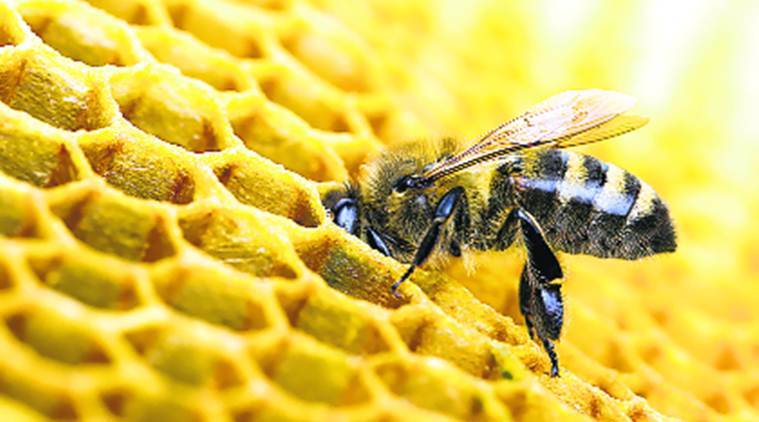To bee or not to bee
There is little data in India on the number of bee colonies and bee-keepers, or the honey produced.

Apiculture is still so informal and unorganised that we don’t have credible numbers on the number of bee colonies and bee-keepers, or the honey produced.
Suk Mahammad Dalal is from Chandramonipur, West Bengal. He collects honey. He has become famous because of a video floating around on the internet. The video shows him stuffing thousands of bees down his vest, while he collects honey from the hive. There is a bit of science behind this since if you are repeatedly stung by a bee, immunity develops. There is yet another video floating around, this one about an apiculturist named Jisha, from Thiruvananthapuram. In the video, her face is covered with bees.
Not all bees sting. Nevertheless, the average person wouldn’t like to stuff bees down the vest, or cover their head with buzzing bees, especially if that average person has watched a film like The Swarm. Not all bees are honey bees. Honey bees belong to the genus Apis and from an Indian perspective, the relevant species are Apis Florea, Apis Dorsata, Apis Cerana and Apis Mellifera. Next to your house, when you see a nest of bees hanging from a tree, that’s Apis Dorsata (also known as the rock bee). These are largish bees. They can’t be domesticated, so to speak. They sting and they sting hard. Suk Mahammad Dalal’s bees are Apis Dorsata. A sub-species of Apis Dorsata, known as Laboriosa, is found in Himalayan regions. If you are going to get into proper apiculture, and not just occasional gathering of honey, such as in the Himalayan regions or in the Sunderbans, you might as well forget about Apis Dorsata.
“When you go after honey with a balloon, the great thing is not to let the bees know you’re coming.” That’s Winnie the Pooh and when we think of honey bees, we invariably think of honey. Bees have a significant role as pollinators. As bee products, other than honey, there exists pollen, propolis, royal jelly, wax and venom. All of these have uses and markets. Any figure about the productivity of honey bees will be contested, with valid reason. Is the sample credible? Surely, the answer depends on whether apiculture has been professionally undertaken. What about the pollination aspect? With that qualification, here are some indicative numbers. Per colony per year, as an average number, Dorsata will yield 50-80 kg of honey, Florea 200-900 grams, Cerana (the sub-species known as Cerana Indica) 6-8 kg and Mellifera 25-40 kg. Florea is a small bee. Small amounts of Florea honey may be collected in Gujarat, but no one will be seriously interested in Florea for commercial reasons. Despite relatively lower productivity, Cerana Indica has been around for hundreds of years, particularly in the southern parts, though a viral disease in 1991 wiped out many colonies. This leaves Mellifera, known as the European bee. (Despite being known as the European bee, it originally came from Africa, as did all humans.)
Mellifera is not indigenous. It was “imported” in the 1960s in Punjab and has gradually become popular everywhere, because of higher yields and because Mellifera is not as aggressive as Dorsata. Unless you provoke it, a Mellifera will not normally sting. If it stings, it won’t hurt much. Mellifera is a more domesticated bee than Dorsata. The bees that cover Jisha’s face are Mellifera. Therefore, from an apiculture point of view, it is Dorsata, Cerena Indica and Mellifera.
Why, despite its low productivity, is Cerena Indica popular in the south and why has Mellifera not taken off? An apiculturist gave me a reason. There is a bird known as bee-eater. As the name suggests, it eats bees, and also wasps and other flying insects. Mellifera flies straight, Cerena Indica’s flight path is up and down, not straight. The bee-eater bird is common in the south and is not that common above central regions. This bird easily gobbles up Mellifera, Cerena Indica tends to escape. I tried to confirm this with entomologists. They neither confirmed nor denied it. For all one knows, Mellifera introduction started in Punjab and then percolated to Himachal, UP, Bihar and Maharashtra. It is only a matter of time before it spreads southwards. Start-up costs are also higher for Mellifera.
Apiculture is still so informal and unorganised that we don’t have credible numbers on the number of bee colonies and bee-keepers, or the honey produced. A ballpark figure is production of 95 thousand metric tonnes and export of 45 thousand metric tonnes. For that matter, we aren’t clear about what we mean by honey, though its consumption is increasing because of health reasons.
In a general way, everyone knows what honey means. For example, in Prevention of Food Adulteration Rules (1955), “Honey means natural sweet substance produced by honey bees from the nectar of blossoms or from secretions of plants which honey bees collect, transform, store in honeycombs for, ripening”. We are also clear about prohibiting contaminants, adulterants, insecticides and pesticides, although Indian exports have sometimes been banned because exporters violate these norms. Bees collect honey. Therefore, natural honey will have pollen. Natural honey will crystallise.
The sugar in honey has both fructose (F) and glucose (G). Glucose crystallises, fructose doesn’t. The F/G ratio should be 0.95 and certainly not more than 1.00. As consumers, we have read about honey being good for health, but we don’t like pollen. We don’t like crystallisation. Those who manufacture honey increase fructose content and mix natural honey with sugar syrup. There is something known as the Fiehe test and in a 2015 test by Consumer Voice, a few brands failed this test. “Natural” honey isn’t necessarily that.
The writer is chairman, Economic Advisory Council to the PM. Views are personal
For all the latest Opinion News, download Indian Express App
More From Bibek Debroy
- Pets and peevesBengaluru municipality’s new pet licensing laws are beset by the familiar failing of public policy — confusion and multiplicity of objectives ..
- A justice more efficientThe Legal Information Management and Briefing System aims to improve Union government’s handling of cases. Its data can also be used to reduce litigation, declog…
- Eighteen to sixty-fourEighteen to sixty-four should be the age range of the working population factored into policy, since enrolment in senior secondary school is rising...








































No hay comentarios:
Publicar un comentario